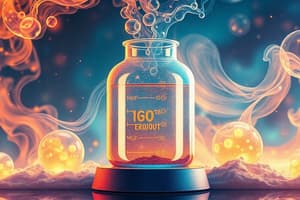Podcast
Questions and Answers
Is the self-ionisation of water exothermic or endothermic?
Is the self-ionisation of water exothermic or endothermic?
- Depends on the temperature
- Exothermic
- Neither exothermic nor endothermic
- Endothermic (correct)
If you increase the temperature, will the concentration of [H3O+] increase or decrease?
If you increase the temperature, will the concentration of [H3O+] increase or decrease?
- Depends on the initial concentration
- Increase (correct)
- Remain constant
- Decrease
Is the pH of water constant?
Is the pH of water constant?
- Constant only at 298 K
- No
- Yes (correct)
- Constant only at 100°C
Will the pH of water be higher or lower than 7.00 at 100°C?
Will the pH of water be higher or lower than 7.00 at 100°C?
What is the equilibrium expression (Kc) for the self-ionisation of water?
What is the equilibrium expression (Kc) for the self-ionisation of water?
What is the ionic product of water, Kw, at 298 K?
What is the ionic product of water, Kw, at 298 K?
How can you convert [OH-] into [H3O+] using Kw?
How can you convert [OH-] into [H3O+] using Kw?
What is used as a handy tool to convert [OH-] into [H3O+]?
What is used as a handy tool to convert [OH-] into [H3O+]?
What is the pH of pure water at 298 K?
What is the pH of pure water at 298 K?
What is the dissociation equation for RbOH in water?
What is the dissociation equation for RbOH in water?
Flashcards are hidden until you start studying
Study Notes
Chemical Equilibrium
- Chemical equilibrium is a state where the rates of forward and reverse reactions are equal, and the concentrations of reactants and products remain constant.
- The position of equilibrium is a measure of the percentage of reactants converted to products.
- If the equilibrium lies to the left, less than half of the reactants are converted to products, resulting in a low yield of products.
- If the equilibrium lies to the right, more than half of the reactants are converted to products, resulting in a high yield of products.
Le Chatelier's Principle
- Le Chatelier's Principle states that a system at equilibrium will try to resist any changes to the equilibrium conditions.
- If the temperature is increased, the system will try to cool down.
- If the pressure is increased, the system will try to reduce the pressure.
- If the concentration of a reactant is increased, the system will try to remove the excess reactant.
Effect of Concentration on Equilibrium
- If the concentration of a reactant is increased, the system will try to remove the excess reactant by promoting the forward reaction, causing the equilibrium to shift to the right.
- If the concentration of a product is increased, the system will try to remove the excess product by promoting the reverse reaction, causing the equilibrium to shift to the left.
- If the concentration of a reactant is decreased, the system will try to make more reactant by promoting the reverse reaction, causing the equilibrium to shift to the left.
Effect of Pressure on Equilibrium
- If the pressure is increased, the system will try to reduce the pressure by promoting the reaction that produces fewer moles of gas, causing the equilibrium to shift to the right.
- If the pressure is decreased, the system will try to increase the pressure by promoting the reaction that produces more moles of gas, causing the equilibrium to shift to the left.
Acid-Base Equilibrium
- For a weak acid HA, the acid dissociation constant (Ka) represents the extent of dissociation in water.
- A higher Ka value indicates a stronger acid, which dissociates more in water.
- The pH of a solution can be calculated using the Ka value and the concentration of the acid.
Self-Ionisation of Water
- Water self-ionises to form H3O+ and OH- ions, with an equilibrium constant Kw = 1.00 x 10-14 mol2 dm-6 at 298 K.
- The pH of pure water is 7.00 at 298 K.
- The self-ionisation of water is an endothermic process, meaning that the concentration of H3O+ increases with increasing temperature.
Studying That Suits You
Use AI to generate personalized quizzes and flashcards to suit your learning preferences.



